It is frustrating as fans to see gashes in the Oregon defense and know that something is going wrong, but not be able to pinpoint what it is. We are fortunate to have the guidance of the Grizzled Ol’ Coach, Mike Morris, to help us understand not only what went wrong in the game against Washington State, but to help us see the fundamental principles that define the 4-3 defense Oregon is trying to run.
Should Oregon coaches have their jobs on the line? That is not for this article, as Mike already suggested some coaching changes in an editorial yesterday on FishDuck.com. (It was simply outstanding in so many ways) Instead, this analysis will focus on the foundation players in the 4-3, the defensive tackles, and how their implementation of simple tactics and techniques form the heart of a good run defense.
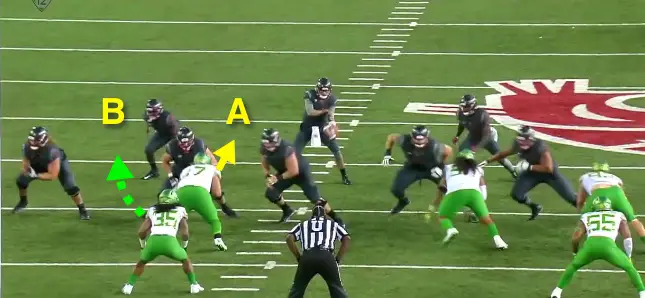
The Oregon defensive tackle has the “A” gap.
At the beginning of the play above, we see how the Oregon defensive tackle (yellow arrow and is technically the Nose Tackle) is lined up on the inside shoulder of the guard in a 2i (i for inside) technique, as the coaches would say. He is responsible for the “A” gap, the area between the center and the guard. Just lining up this way gives him a huge advantage in penetrating this gap as the WSU center (to our right of the “A”) charges out of his stance to engage.
The green dotted line above, indicates where the linebacker is going to protect – the “B” gap between the WSU guard and offensive tackle.

The center-guard combo block is working on the NT for Oregon.
The running play above has begun and you can see how No. 39, (looks like No. 35, but is not) the Duck linebacker, is moving toward his “B” gap to fill. The Duck defensive nose/tackle has his hands full with the combo block of the center (to his right) and the offensive guard (to his left) and he MUST penetrate the “A” gap. It is critical that he pierce through enough to make the guard stay with the center, continuing the double-team block. This way the linebacker can plug the “B” gap as planned.
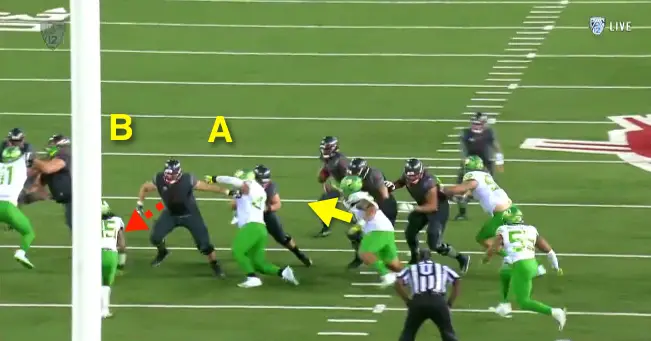
Yikes.
The guard for WSU (red dotted line, above) feels that the center has the Oregon defensive nose/tackle handled; thus he can peel off to attack the Duck linebacker. Note the defensive tackle moving over. (yellow arrow above)
You can see (above) how to the extreme left the offensive tackle and tight end have the Oregon defensive end tied up as well. Again, the defensive nose/tackle MUST get inside the block of the center to protect the “A” gap. Fundamentally, once a blocker has his head between you and your objective (in this case, the “A” gap), then you have lost leverage and have been successfully blocked.
If No. 47 (the Duck defensive nose/tackle) had got his head inside the “A” gap and penetrated, the running back could not run through that gap. Had he tried, the play would have been stopped at the LOS quickly.

It’s all over but the screamin’ …
The screenshot above makes me ill. The center had a bad angle to start and now has leverage on the Duck defensive nose/tackle (yellow arrow, above) to create a lane on one side that the Cougar running back (light blue dotted line) is dashing through.
Look how far away the linebacker is from the gap; when the linebacker meets the offensive guard (solid red arrow above), it will be five yards off the LOS. That guarantees at least a good, if not great running play for the opponent. Grizzled Ol’ Coach spoke of how fast Joe Walker would identify the play and hit his gap in a flash before the peel-off blocker could get to him. He has also stated that Kiko Alonso was even faster. Really, a fraction of a second in reaction time makes all the difference here.
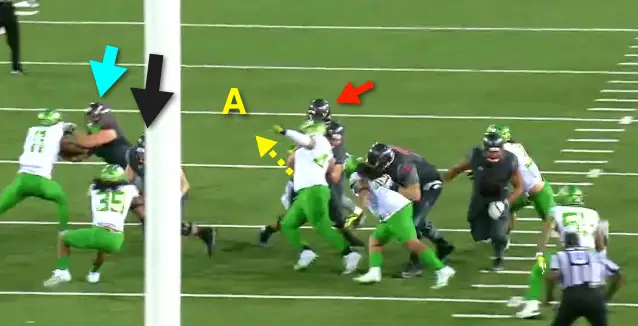
This will be trouble …
The WSU center (red arrow, above) had made a terrific reach block as the Oregon defensive nose/tackle (yellow dotted line) is unable to penetrate and plug the “A” gap. Note how the Cougar offensive guard (black arrow, above) is in great position to crush the Duck linebacker, and the WSU offensive tackle (light blue arrow, above) has the defensive end away from the play.
It all starts with the defensive nose/tackle; if he penetrates, the play is stuffed at the LOS. If he occupies both blockers (which plugs the “A” gap), then the Oregon linebacker is free to plug the “B” gap and that forces the running back to bounce outside, where the defensive end is waiting (another fundamental goal of the defense, but that is another analysis).
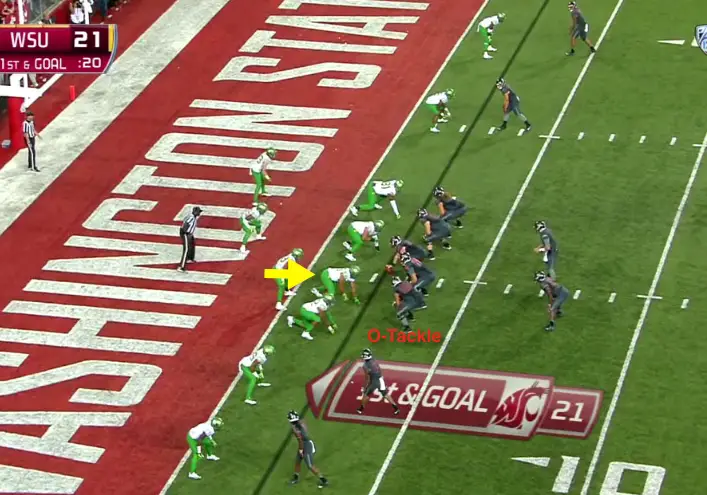
Look carefully how they are lined up …
But that is not where the misery ends, as there were issues with the other defensive tackle spot for the Ducks. Note the right defensive tackle above (yellow arrow) is lined up on the outside or left shoulder of the offensive guard. This is a “3” technique, and his job is to penetrate the “B” gap in front of him between the guard and tackle and occupy the guard so that the right linebacker behind him can protect the “A” gap on that side of the center.
Please note that outside the defensive tackle of Oregon, is the Cougar offensive tackle and you can see it so indicated above.
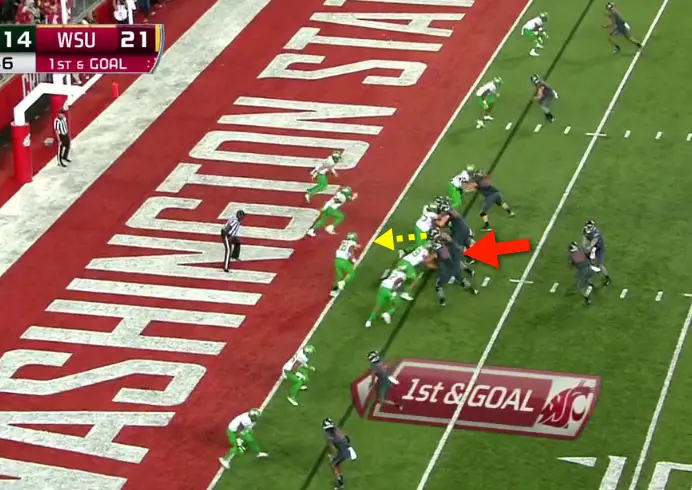
He is not penetrating the gap!
Just after the snap (above), we see the offensive tackle slide to his right and combo block with the guard on the Duck defensive tackle. The man in green should have had his head inside that gap and inside the offensive tackle of WSU. Now it appears that the tackle is taking control of the block as he is “sealing” the Duck defensive tackle out of the gap. Meanwhile, the offensive guard (yellow dotted line above) is preparing to release and block the linebacker (who should be attacking downhill) to open the “A” gap for the Cougar ball carrier.
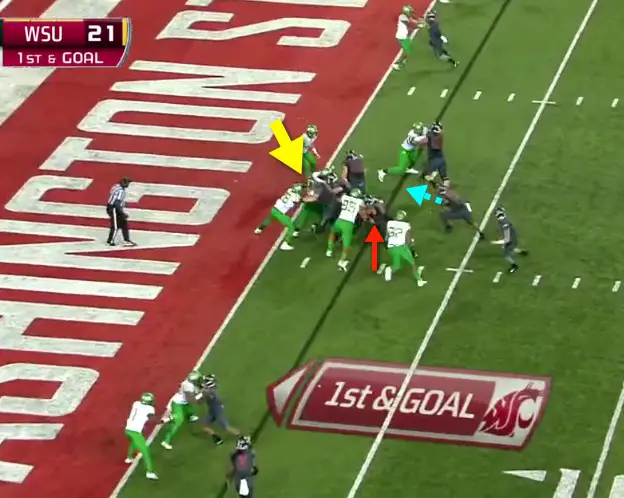
This is not complicated …
The worst of all outcomes is taking place above. The offensive tackle was way outside the Duck defensive tackle to start the play and yet he was able to reach block and seal the gap inside by putting his head (and body) in front of where the Oregon DT wanted to go. But it gets worse, as the offensive guard (yellow arrow above) has peeled off to block the Oregon linebacker allowing the WSU running back (light blue arrow above) to run unimpeded into the end zone.
There a couple of simple rules for defensive linemen in a one-gap 4-3 defense, and one of them is to never let the blocker you’re attacking “hook you” and get his head and far-side shoulder past you because then you have lost your gap control.
Second, penetrate like a SOB and require both offensive linemen to continue blocking you, thus allowing the linebacker to run free. If one offensive lineman leaves that combo block on you, then you better penetrate that gap by getting your head inside of the offensive lineman in the gap!
Apologists for the Oregon defense want to talk about the difficult adjustment from the 3-4 defense to the 4-3. The GOC says, “baloney” (Not really, but you get the idea). He believes that Arik Armstead and DeForest Buckner would be tearing things up in this new defense.
”The 4-3 defense is much easier to learn and play … just get your ass in the gap and attack!”
This is the first of nearly 250 analysis articles over five years where we demonstrated the negative instead of the positive plays. My attitude on this is that the primary focus is to learn football so we can enjoy the game more. By reviewing the plays that went badly, we achieve two objectives.
First, we help to answer some of the questions fans have about the Oregon defense, and second, we learn a lot about the one-gap 4-3 defense that the Ducks are working to implement. It will help us fans to watch the progress and the positive plays that will come over time.
“Oh how we love to learn about our beloved Ducks!”
Charles Fischer (FishDuck)
College Football Analyst for FishDuck.com
Eugene, Oregon
(Note: I did not list player names as they work hard enough without being singled out. One assistant coach is highly paid to simply teach the defensive tackles–two positions is all–the correct technique.)
Top Photo from Video
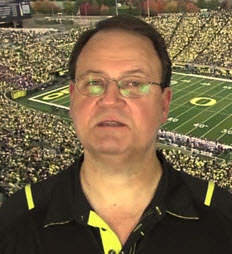
Charles Fischer has been an intense fan of the Ducks, a season ticket holder at Autzen Stadium for 35 years and has written reports on football boards for over 23 years. Known as “FishDuck” on those boards, he is acknowledged for providing intense detail in his scrimmage reports and in his Xs and Os play analyses. He and his wife Lois, have a daughter Christine, reside in Eugene Oregon, where he was a Financial Advisor for 36 years and now focuses full-time on Charitable Planned Giving Workshops for churches and non-profit organizations.
He does not profess to be a coach or analyst, but simply a “hack” that enjoys sharing what he has learned and invites others to correct or add to this body of Oregon Football! See More…


